Costa’s Hummingbird: Jewel of the Desert
Updated: Jul. 10, 2024
Find out what a Costa's hummingbird looks like. Also discover the southwestern range where you can see this tiny yet dramatic bird.
On This Page
Costa’s Hummingbird Identification
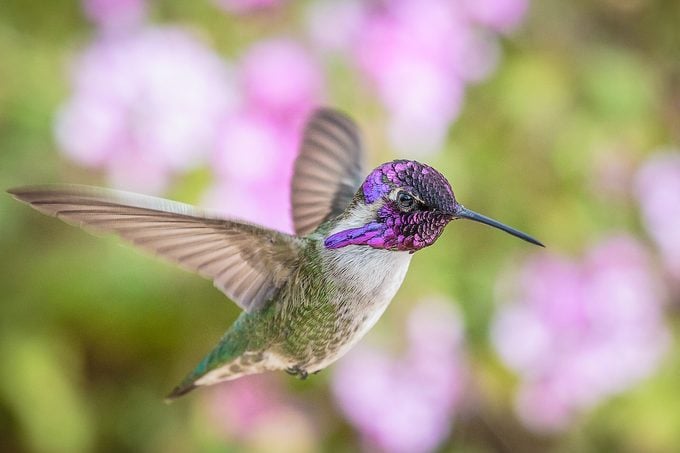
Measuring only 3½ inches long, the Costa’s hummingbird is a pint-sized delight in its arid habitats, weighing in at only one-tenth of an ounce.
The male has a hunched appearance with a stubby tail, and is easily identified by its green back and iridescent purple on its head and around its throat. “This is a very small species of hummingbird, all-green back with no rufous (brown) coloration. The underside is light colored, light gray on the flanks to white on the belly, and, in females, a white chin. Adult males have a brilliant purple throat and crown (top of head),” says Christopher Clark, assistant professor of biology at the University of California, Riverside.
Meet more types of hummingbirds found in the United States.
Female Costa’s Hummingbird
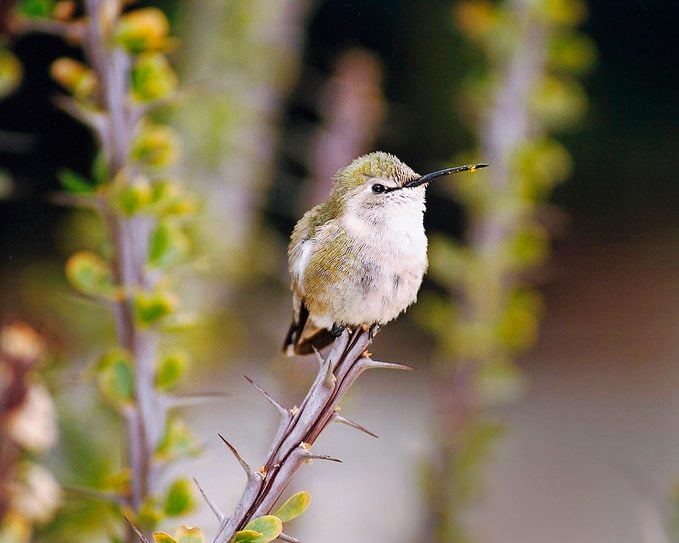
The green and white females look similar but lack the bold purple throat and head feathers of the males. To identify them, look for a gray cheek patch and a white eyebrow.
Juvenile
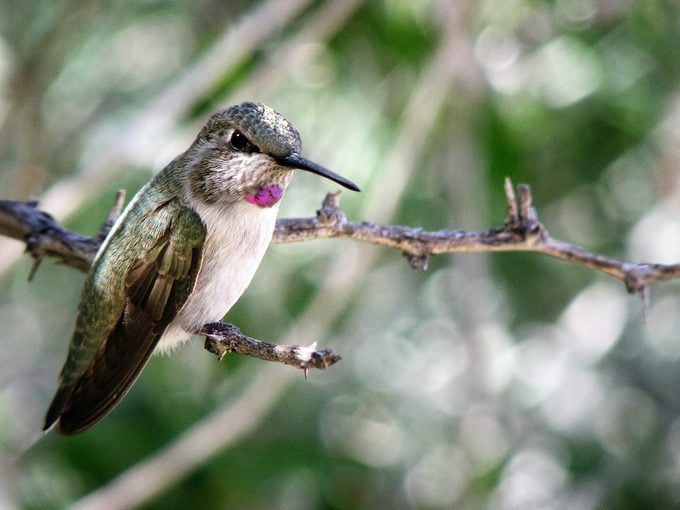
Birding experts Kenn and Kimberly Kaufman say, “Young male hummingbirds are tricky to identify, because they’re often somewhere between the appearance of a female and an adult male.”
Reader Steve Dummermuth Jr. asks, “I took this photo (above) near Scottsdale, Arizona. I think it’s an immature male, but is it a black-chinned or an Anna’s?”
Kenn and Kimberly say, “We think this is a young male Costa’s hummingbird for several reasons. The dark outline of the throat patch, extending down and back below the eye, is very typical of Costa’s at this stage, and so is the patch of pinkish purple on the lower throat. Also, the breast and sides are clear whitish—most Anna’s and black-chinneds show more of a gray-green wash on the sides.”
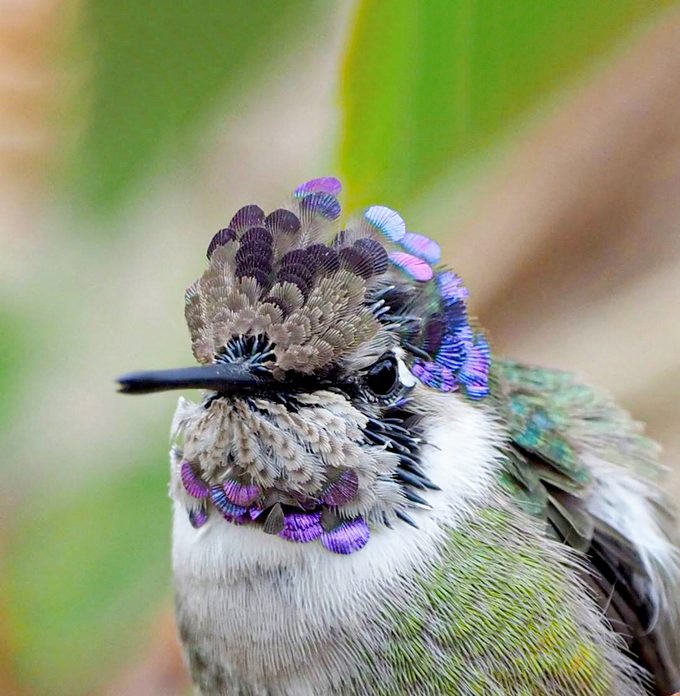
“One of my favorite photos ever was of this young Costa’s hummingbird (above) just getting in his beautiful feathers,” says reader Lisa Swanson.
Call and Sounds
Male Costa’s hummingbirds are regular singers, making a thin, piercing whistle. With other species, the most common sounds are aggressive calls, which resemble chattering or squealing. You’ll hear them when several hummingbirds are gathered near a food source such as a sugar-water feeder.
Bird songs courtesy of the Cornell Lab of Ornithology.
Courtship Displays
Christopher says the Costa’s unique breeding ritual involves a male flying directly in front of a female, flaring his purple feathers and creating the appearance of a baby octopus on his head. Another display entails repeated looping dives on either side of the female while singing. Christopher says their song is of a remarkably high frequency, and their narrow feathers make a practically identical sound.
A male Costa’s hummingbird can amplify the sound of his tail feathers by 11 decibels by directing the angle of those feathers toward the female during the courtship rituals.
“A male performs shuttle displays in which he flies back and forth right in front of the female with the iridescent purple gorget flared, so that he looks like an amazing little star. He also does a dive in which he ascends 100 feet up in the air and then descends in a huge oval, making a high pitched eeeEEEEEeeee! sound with his tail as he dives,” Christopher says.
Heart Rate
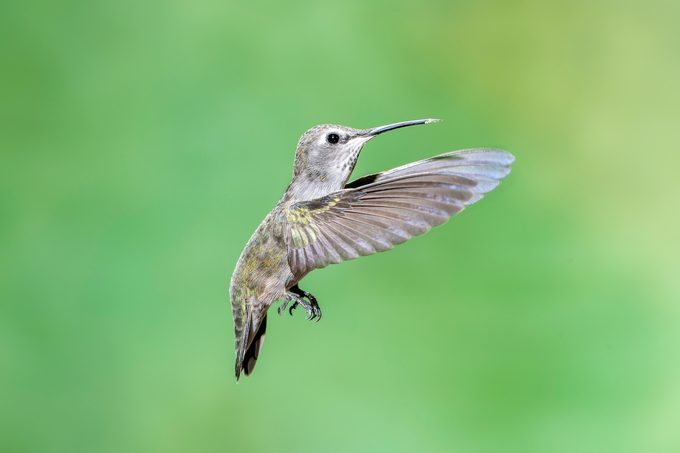
During normal daily activity, the heart rate of Costa’s hummingbirds ranges between 500 and 900 beats per minute. When the temperature drops below 50 degrees, the birds enter a torpor, and their heart rate slows to around 50 beats per minute.
Nesting Habits
Like other types of hummingbirds, the female Costa’s does all of the nest building and parenting work herself.
“After mating, the female goes off on her own,” Christopher says. Combining bits of leaves, lichen and bark, she creates a cupped nest with a 11/4-inch diameter, and “she’ll use a bunch of spiderwebs to glue the nest together.” Inside, there is fluff to keep the eggs warm.
Christopher says she’ll lay two eggs the size of jelly beans that weigh 0.4 grams apiece. “Each egg equals 20% of her body mass and is incubated for 14 to 18 days.”
After hatching, the chicks are fed insects by the female for the first two weeks. “The last week, she will feed them nectar,” Christopher says.
He notes that where people are providing consistent food sources, like feeders and gardens, the birds may extend their breeding season and begin nesting as early as the fall months, enabling them to raise multiple broods in a year.
Learn more about the fascinating life of a female hummingbird.
How to Attract Costa’s Hummingbirds
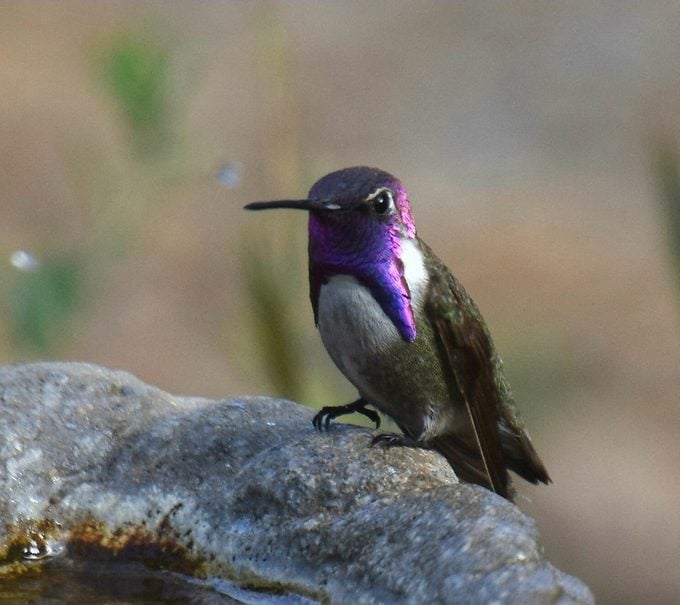
To catch a glimpse of these vivacious hummingbirds, put up one or two sugar-water feeders and add some native plants to your landscape. “People in the desert do have them in their backyard,” Christopher says. “These birds love feeders.”
As for nectar plants to attract them, he says Costa’s are attracted to chuparosa and ocotillo shrubs, but “there are a lot of nonnatives that they love. Salvias, such as Mexican sage, are favorites,” he says.
Then listen for their distinctive high-pitched call or watch for the male’s flashy violet facial markings.
Range and Migration
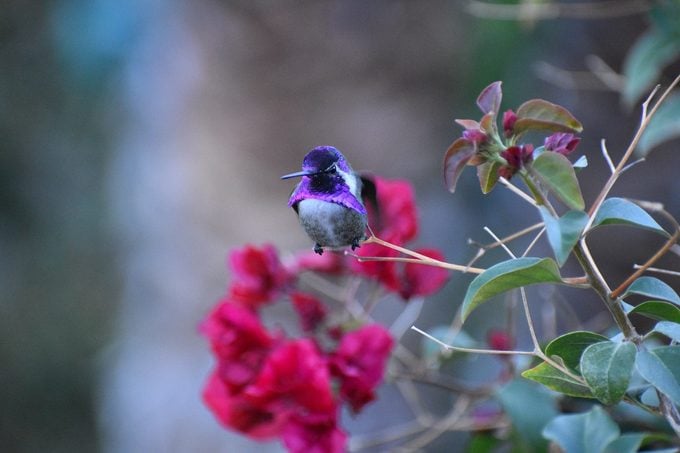
To see these birds, you’ll need to look in the southwestern states.
Partly residing in the Sonoran and Mojave deserts in March and April, Costa’s thrive in the heat, says Christopher. However, they wander toward the sagebrush scrub communities of coastal California to escape the most intense heat beginning in May.
Christopher says, “They breed in the winter, starting in low elevation Sonoran desert. Later in the spring (April) they shift to sage scrub habitat. When the breeding season ends by late June, they wander. It’s not clear how far they go, or whether this wandering should be considered to be an actual migration. In some places, they remain all year-round. They return to their breeding areas in approximately November, when the chuparosa flowers begin to bloom in the desert.”
How Did the Costa’s Hummingbird Get Its Name?
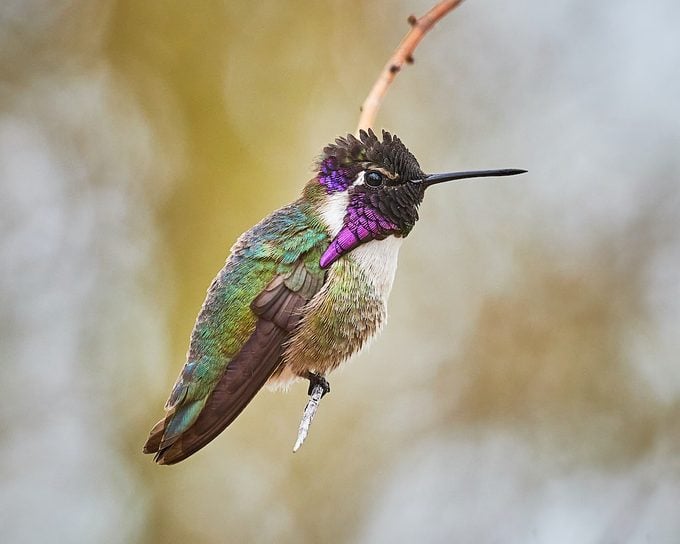
It was named in honor of Louis Marie Pantaléon Costa, Marquis de Beauregard, a French nobleman. The bird was collected on an expedition of the French ship Vénus, which stopped in Baja, California, and a French hummingbird biologist, Jules Bourcier, named it after the Marquis.
Costa’s Hummingbird Hotspot
Tohono Chul Park lies within the Sonoran Desert in Tucson, Arizona. This park provides easy walking trails and gardens to view some of the 140 bird species that visit the 49-acre site. A hummingbird garden attracts Anna’s, broad-billed and Costa’s hummingbirds year-round to sip nectar from salvia, desert willow and other plants. Migration brings rufous, broad-tailed, calliope and black-chinned hummers.
About the Experts
Hummingbird researcher Dr. Christopher J. Clark is an assistant professor of biology at the University of California, Riverside. Christopher has a Ph.D. from UC Berkeley, with research on hummingbird tail morphology.






















